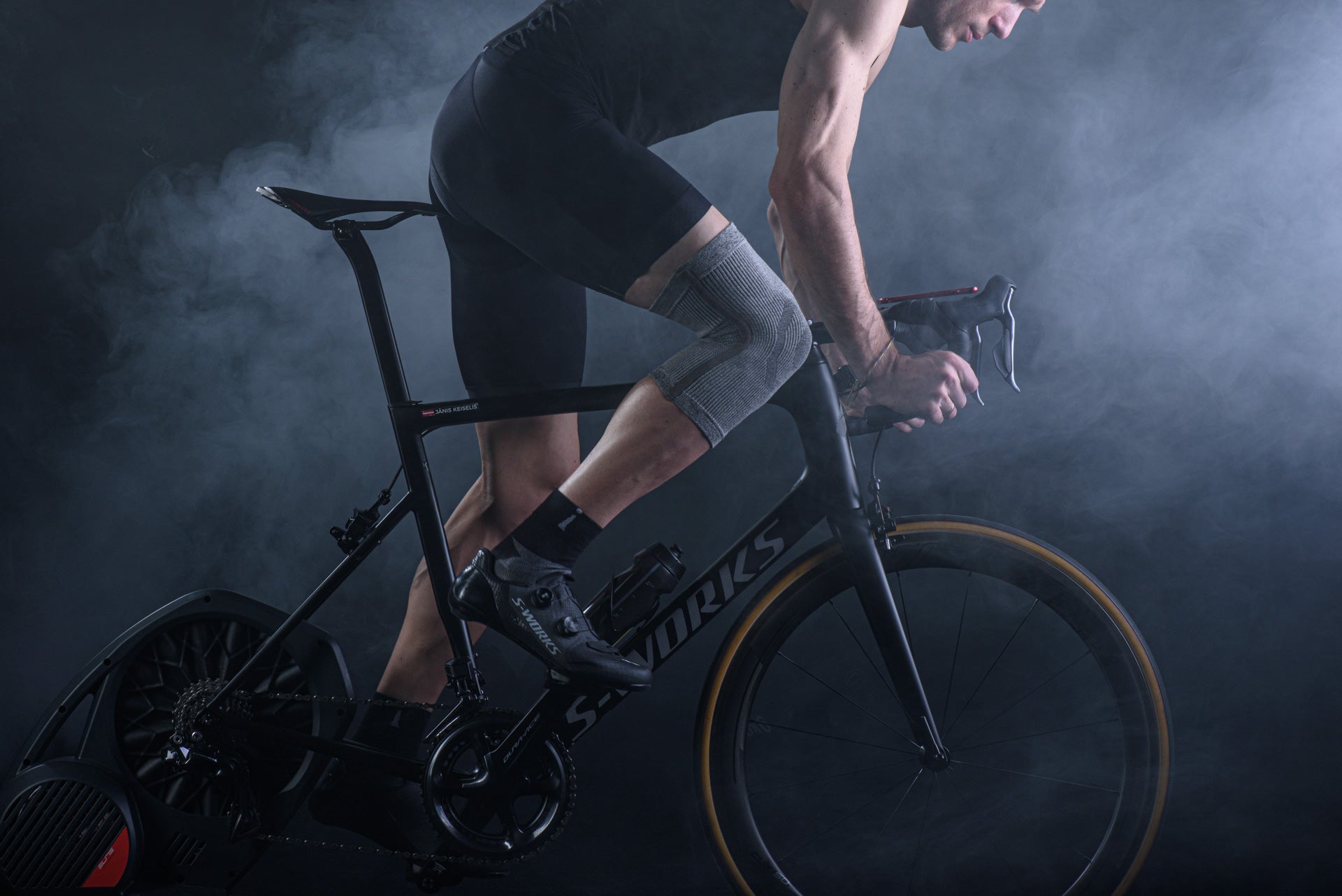May is National Bike Month. Established in the 1950s and promoted by the League of American Bicyclists, National Bike Month is a celebration of all things cycling and a great opportunity for new people to get into the sport.
Cycling has countless benefits. It’s a cost-effective form of transportation, faster than walking and far cheaper over time than public transit or driving. Cycling is a fun, low-impact form of cardiovascular exercise which gets your heart beating faster while being gentle on your joints. Regular cardio exercise helps you to maintain a healthy weight, fight off diseases such as cancer and diabetes, and even maintain good mental health.
Cycling also helps to strengthen your joints and muscles, improve your posture and coordination, and keep your bones healthy. So if you don’t already, why not hop on the saddle and give cycling a go this month?

How to Stay Safe on Your Road Bike
Like many sports, cycling does carry some risks. Those risks increase if you are cycling on the road, which many people do—particularly those who use cycling for transportation. But with a bit of know-how and a few basic safety precautions, you can ensure you stay safe and injury-free on your bike rides.
In this section, we will share some top tips to help you stay safe on your road bike this month and beyond.

Always Wear a Helmet
We always recommend that you wear a helmet, as a blow to the head can be fatal.
According to the Cleveland Clinic, around two thirds of cycling-related deaths and one third of injuries involve the head and face. Wearing a helmet can reduce the risk of head injury by up to 85%.
Never use a second hand helmet and, if you have an accident involving a head impact, retire your helmet and buy a new one. Look for a helmet with the Consumer Product Safety Committee (CPSC) sticker (helmets manufactured after 1999 are required to meet this standard) and, if possible, get fitted for your helmet by a professional at a reputable cycling store.
Use Reflective Clothing
One of the biggest dangers when riding on the road is motorists not seeing you until it’s too late. That’s why reflective clothing is so important, especially when riding in the dark, at dusk, or in poor weather.
Reflective clothing works by bouncing light back in the direction it came. In other words, when a car’s headlights hit your reflective garment, the light is directed back towards the car, greatly increasing the likelihood that the driver will see you.
You can buy reflective jackets, gilets, socks, gloves, backpacks, vests, and more at cycling stores or online.
Make Sure Your Bike’s Lights Work
Like reflective clothing, bike lights make it easier for motorists to see you in the dark and in low light conditions. They are also required by law in many places, and you can be stopped by the police and fined if you ride in the dark without them.
Before heading out on a bike ride, make sure that your lights are fitted, correctly positioned, and in good working order. If you regularly go on long rides, it can be a good idea to carry a spare light just in case one of yours fails.

Pay Attention to Traffic Lights and Road Signs
As a cyclist, you are considered a road user and must obey all the laws of the road. This means paying attention to road signs and traffic lights and obeying them. Running a red light as a cyclist, for example, can be extremely dangerous as oncoming cars will not be expecting to see you. You also need to look out for stop signs, school zones, railway crossings, and signs indicating that you must yield to pedestrians.
Don’t forget to pay attention to signs specifically for cyclists, too. Cycle About Town has a useful guide to the most common signs you’ll encounter.

Keep Your Bike in Good Condition
Modern bikes are designed with safety in mind, but your bike is only as good as its condition. Therefore, check it over regularly, paying particular attention to these areas:
- Are the tires inflated properly?
- Is it clean?
- Are your brake pads worn? If so, replace them.
- Are your brakes squeaking? If so, clean or adjust them.
- Are the parts where metal touches metal well lubricated?
It is also a good idea to get your bike professionally serviced once per year, or more frequently if you cover significant mileage each week.
Stay on the Road
Counter-intuitive though it may seem, you should always cycle on the road and not on the sidewalk (unless the sidewalk has a designated bike lane). Cycling on the sidewalk makes you less visible to motorists, increasing the risk of accidents. It is also dangerous to pedestrians, who are not expecting to see a cyclist on the sidewalk.
How to Keep Cyclists Safe as a Driver
When you are driving a car, you are responsible for doing everything you can to ensure your own safety and that of your fellow road users. This includes cyclists as well as other motorists. According to Injury Facts, 806 cyclists were killed in accidents with motor vehicles in 2020, and many more were seriously injured. Many of these accidents were entirely preventable.
Here are a few tips you should follow as a driver to help keep cyclists safe on the road.
Obey the Speed Limit
There are lots of reasons you should obey the speed limit, not least because it’s the law and in place for your safety. But keeping cyclists safe is another great reason. Going too fast increases the risk of accidents, and can increase the likelihood and severity of injury and the risk of death if an accident does happen.
Check Your Blind Spot
If you’re pulling out of a junction or parking space, always look over your shoulder to check your blind spot for cyclists. If you have parked on the road, check before you open your car door, too. This simple action takes less than two seconds and can prevent many collisions with cyclists.
Be Patient
Getting stuck behind a cyclist can feel frustrating, but they have just as much right to be on the road as you. Therefore, exercise patience and be respectful to cyclists on the road. Don’t try to merge until you are in a safe place to do so. Never merge on bends or anywhere you do not have a clear view of the road ahead.
Give a Wide Berth When Merging
According to statistics collected by SKODA, 40% of cyclists feel unsafe when being merged on. When the merging vehicle is a large vehicle or bus, that number jumps to 61%. You can dramatically increase cyclists’ perceived and actual safety by giving them plenty of space as you pass.
In some countries, the law mandates a distance of at least 1.5 meters (5 feet). This is a good rule of thumb to follow. The average car is about 1.8 meters in width, so it can be helpful to think of leaving at least a car width of distance between you and the cyclist you’re passing.
Avoid Distractions
Huge numbers of avoidable road accidents are caused by distracted drivers. This includes collisions with cyclists. Therefore, avoid using your cell phone, being distracted by passengers in your car, adjusting your vehicle settings unless absolutely necessary, smoking, or taking your eyes off the road to look at your surroundings while you are driving. Simply staying focused and keeping your attention on the road will significantly cut your risks of not seeing a cyclist until it’s too late.
Dip Your Headlights for Oncoming Cyclists
If you see a cyclist coming towards you, dip your headlights. Just as full beam headlights can dazzle other drivers, the same is true for cyclists. This can cause temporary blindness and dramatically increase the risk of accidents. Dipping your headlights lets the cyclist know you have seen them and ensures they can see where they are going clearly.
Try Cycling
The best way to get a sense of how it feels to be a cyclist on a road full of cars is to give it a go yourself. Trying out cycling will give you a greater awareness of the risks and hazards faced by cyclists. You can take this awareness with you next time you’re behind the wheel and use it to become a more courteous, careful driver.
Who knows, you might even enjoy it and decide to cycle more often yourself!

Happy Bike Month
Now that you know how to stay safe, we hope you’ll take this opportunity to get out on your bike and enjoy all the amazing benefits of cycling this month and beyond. We have an event coming up with Streets Are For Everyone (SAFE), a road safety organization dedicated to keeping everyone—motorists, cyclists, and pedestrians alike—safe on our streets.
Riding your bike is also a very strenuous activity on your knees and legs, make sure you stay one step ahead of soreness and injury with the Incrediwear Knee Sleeve!
Happy cycling!
Read more

Do you often find yourself feeling tired or struggling for energy? Fatigue is an extremely common medical symptom, so if you wake up feeling exhausted or find yourself longing for a mid afternoon n...

Animals can bring so much joy to our lives. From cuddling with your pet at the end of the work day to seeing exotic animals at the zoo or watching cat videos on social media, it is well known that ...







Leave a comment
All comments are moderated before being published.
This site is protected by hCaptcha and the hCaptcha Privacy Policy and Terms of Service apply.